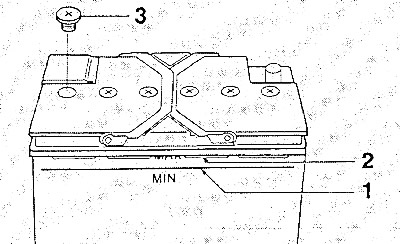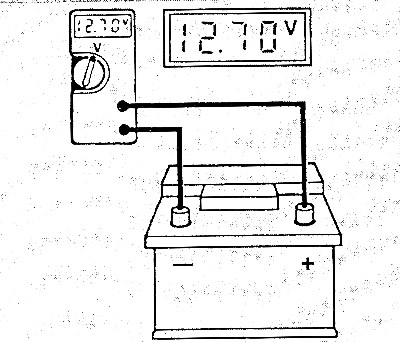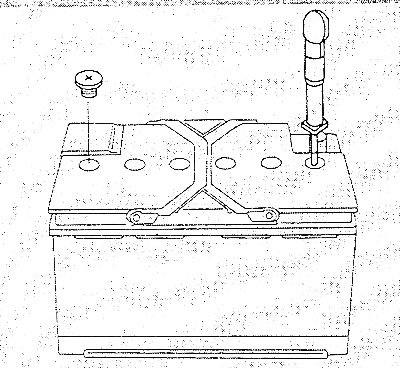Checking the electrolyte level
The electrolyte level in individual banks must be between the marks «MIN» (1) And «MAX» (2). Unscrew plugs if necessary (3) and add distilled water.

Voltage test
The condition of the battery is checked by measuring the voltage between the battery terminals with a voltmeter. О Clean the battery from the outside.
To test, the battery must not be charged for at least 6 hours, including from a running engine. Otherwise, turn on the headlights for 30 seconds before charging.
Switch off the headlights and all other current consumers and wait 5 minutes.

Connect a voltmeter to the battery terminals and measure the voltage.
Evaluation of measurement results:
| 12.7V or higher | Battery in good condition |
| 12.6 V | Battery normal |
| 12.4V or below | Battery in bad condition, charge or replace it |
Battery test under load
Connect a voltmeter to the battery terminals.
Start the engine and measure the voltage.
When starting the engine with a fully charged battery, the voltage should not fall below 10 V (at +20°C).
If the voltage drops sharply, and the density of the electrolyte in the banks of the battery is different, then this indicates a malfunction.
Electrolyte Density Check

The density of the electrolyte, combined with the voltage, gives an accurate indication of the state of charge of the battery. Remove caps from jars. Density meter required for verification (hydrometer). Electrolyte density is measured in g/ml (g/cm3) or in degrees Baume (+°Be'). The following values should be received:
| State of charge | +°Be' | g/ml |
| discharged | 16 | 1,15 |
| Half discharged | 24 | 1,22 |
| well charged | 30 | -1,26 |
Check all the battery banks in turn - they must have the same electrolyte density (allowable difference - 0.04 g/ml). If this is not the case, then the battery is defective.
